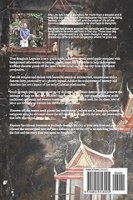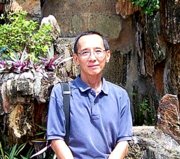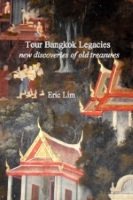- Home
- Bangkok Museums
- Baan Kudichin Museum
Baan Kudichin Museum
preserving the Portuguese heritage
By Eric Lim

The Baan Kudichin Museum preserves the history, culture and traditions of an old Portuguese-Thai community in Thonburi that dates back 250 years to the days of old Siam.
This museum is housed in a building that used to be the home of a Catholic family in the Kudichin Community and the descendants of the original owner decided to convert the home to a museum to preserve the heritage of their community.

Artist's impression of the Baan Kudichin Museum
Organisation of the museum
The museum is organized
into four sections
· Café, souvenir shop and garden
· Second floor – arrival of the Portuguese, after Ayutthaya and the Thonburi era
· Third floor – displays from the family home
· Roof gallery – roof top view of the Kudichin Community
To get there, please see map to the Baan Kudichin Museum.
The Rooster in the House
Visitors to the Baan Kudichin Museum can’t help but notice a huge board with the image of a white rooster against a red background. No, this has nothing to do with the Year of the Rooster. The rooster here is based on the Legend of the Rooster of Barcelos, a city in Northern Portugal.
In the 15th C, a pilgrim passing through Barcelos was accused of theft and sentenced to the gallows. He swore his innocence and asked to see the judge who condemned him.
He was brought to the judge’s home where the judge was entertaining guests to a banquet. The condemned man declared his innocence and pointed to the rooster on the dining table.
“As proof of my innocence, that rooster will crow at the hour of my hanging!”
He was dismissed with derision and dragged away to the gallows. No one touched the rooster after that and as the rope was put around the pilgrim’s neck, the rooster rose and crowed!
The condemned man was immediately exonerated and released. The miracle of the Rooster of Barcelos (Galo de Barcelos) lived on and became a symbol of honesty, trust integrity and honour. It’s also became a national symbol of Portugal.

The Rooster of Kudichin
The rooster has been adopted by Baan Kudichin Museum to reflect the Portuguese heritage of the Kudichin Community.
Let’s take a tour of the Baan Kudichin Museum by going up to the second floor to trace the arrival of the first Europeans in South-east Asia.
The Portuguese in Siam
As a schoolboy, accounts of the voyages of the Portuguese explorers fired my imagination. In the reign of King Manuel I (1469 – 1521) the small maritime kingdom of Portugal sailed out to discover the far corners of the world, it was the Age of Discovery.

Portuguese map of East Asia
In 1498 Vasco da Gama became the first man to sail from Europe to India. Before da Gama embarked on his long journey, he and his men spent the last night praying at the hermitage founded by Henry the Navigator.

Vasco da Gama (1469 – 1524)
To commemorate da Gama’s success, King Manuel I built the Jeronimos Monastery on the site of the hermitage in 1502. Jeronimos Monastery in Lisbon is a World Heritage monument today.
Da Gama’s body is entombed in this monastery. Subsequent generations of sea explorers prayed here before commencing their journeys.
In 1509 Afonso de Albuquerque (1453 – 1515) captured Goa in the west coast of India and in 1511, Malacca. With Malacca as a base, the Portuguese reached the East Indies (Timor Leste) and the coasts of China (Macao).
As Malacca was a vassal of Siam, the Portuguese immediately dispatched an envoy in 1511 to Ayutthaya to assure the king that the Portuguese had no aggressive intentions towards Siam.
After further negotiations by two more envoys, a trade treaty was made in 1516 with a trading post established in Ayutthaya, just south of the walled city. The Portuguese bought spices, pepper, rice, ivory and timber from Siam.
In exchange the Siamese imported muskets, cannon, gunpowder, ammunition, copper, Portuguese tiles and Chinese silks from the Portuguese.
The treaty included the provision of mercenaries in the service of the King of Ayutthaya and the introduction of European military tactics to the Siamese army.

Portuguese soldiers
The Portuguese were also granted religious freedom and in 1567 missionaries from the Dominican Order started the first church in Siam, the Dominican Church of San Pedro.

Ruins of the Dominican Church of San Pedro, Ayutthaya
The entry of the Portuguese to Ayutthaya must have caused a stir among the Arab, Indian, Malay and Persian traders who were dominating trade. What did they call the Portuguese?
The word is of Arab origin and dates back to the First Crusades in the late 11th C. The first Crusaders were Franks from Gaul (present-day France), the Arabs called them alfaranja.
Later when other Europeans joined the Crusades, they were called by the same name, which gradually came mean Europeans in general. This word was adopted by many other people who came in contact with the Arabs.
When the Portuguese arrived in Ayutthaya, the Arab, Indian and Persian traders who were there long before must have called them a version of this word, alfaranja. The Thais adapted it to Farang to mean all Europeans or Caucasians.
The Fall of Ayutthaya – the Thonburi Era
From 1765, the Burmese launched a massive invasion of Siam, city by city was captured and Ayutthaya fell in 1767. As city went up in flames, Phraya Tak or Taksin slipped out of the doomed city with a band of 200 men.

Phraya Tak leaves Ayutthaya with his men as the city
falls to the Burmese
They rode to the coastal province of Chanthaburi where Phraya Tak rebuilt his army with the help of the Chinese communities there.
Phraya Tak consolidated his forces in Thonburi on the west bank of the Chao Phraya and launched his offensive. In six months, he drove the Burmese out of Siam. In 1768, he ascended the throne as King Taksin in his new capital in Thonburi.

Portuguese troops under Phraya Tak attack the main
Burmese camp near Ayutthaya
The Portuguese continued with their military support for King Taksin during his campaigns against the Burmese and their loyal service was not forgotten.

Portuguese artillery
In Thonburi, King Taksin built his palace, Wang Derm, at the mouth of the Bangkok Yai Canal. He granted a plot of land to the Chinese Buddhists just south-east of the canal in the area occupied by Wat Kalayanamit and the Kuan Yin Shrine.
The Muslim were granted another plot of land south of the Buddhist land around the Bang Luang Mosque.
In an area east of the Buddhist area, he granted land to the Portuguese and the Catholic converts who were mostly Chinese. This land grant, which included permission to build a church, was made on 14 September 1769.
This date is significant to the Roman Catholic and Eastern Orthodox Churches and recalls three historical events:
· the discovery of the True Cross by Saint Helena, the mother of the Emperor Constantine in 326 AD;
· the dedication of churches built by Constantine on the site of the Holy Sepulchre and Mount Calvary;
· and the restoration of the True Cross to Jerusalem by the Emperor Heraclius II in 629 AD.
That day is designated the Feast of the Triumph of the Holy Cross. For this reason, the church was named Santa Cruz or Holy Cross (santo – holy, cruz – cross).

Santa Cruz Church
The Kudichin Community
The land granted by King Taksin to the Portuguese and other Thai Catholics was in an area called Kudichin. One version as to how the area got this name was that it used to be the living quarters of Chinese monks, (hence kuti – monks’ dwelling, chin – Chinese).
As a result, the Portuguese living in this area were called “Farang Kudichin” and one of the cakes made by this community is called kanom Farang Kudichin, (Farang Kudichin cake)
The Santa Cruz Church became the centre for the predominantly Catholic community in Kudichin. The first version of the church completed in 1770 was a wooden building. This was later replaced by another building in 1835. The present church was built in 1916.
The Santa Cruz Kindergarten, Santa Cruz Suksa School and the Santa Cruz Convent were built in the area to serve the community. The community inter-married and their descendants are still living in this area today with their special customs, culture and food.

Narrow soi through the community leading to the Baan Kudichin Museum
An old story in the community tells of a friendly ghost called phi hua prik (Chilly Head Ghost) or phi nu liab (Little Liab Ghost) in the area. Children were told to return home from their play promptly at six in the evening when the bells of the Santa Cruz peal, otherwise they will be kidnapped by this friendly ghost to be his playmates.

Phi hua prik – the Chilly Head Ghost, the neighbourhood friendly ghost
The Family Home and Museum
The Baan Kudichin Museum building is an expanded and renovated version of the original building which was constructed more than 80 years ago. The descendants of the original owner have converted the house into a museum.
Up on the third storey are displays of furniture and other household items in this house which was the home of a Catholic family. The altar dedicated to the Virgin Mary and other religious images are features in Catholic homes before which the families gather to pray at the end of each day.

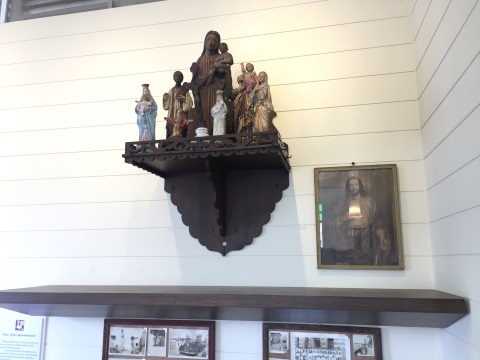
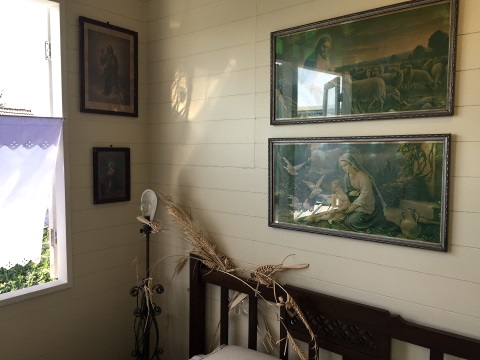

The other displays are of old household items used in the first half of the 20th C. It’s difficult to find such items in modern households today. It may evoke nostalgia for those who do remember these items.
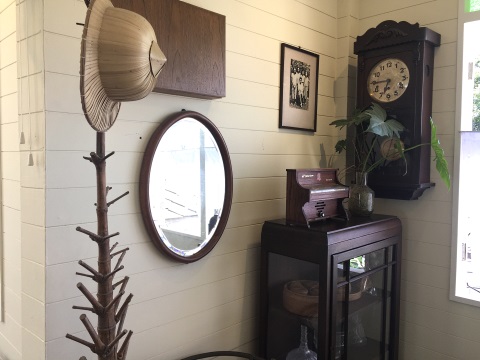


Old household items - recognise anything?
Here are some photos of the lady who was the original owner of this building and some members of her family. I’m afraid I was unable to get the names of those in the photographs as the labels are not up yet.

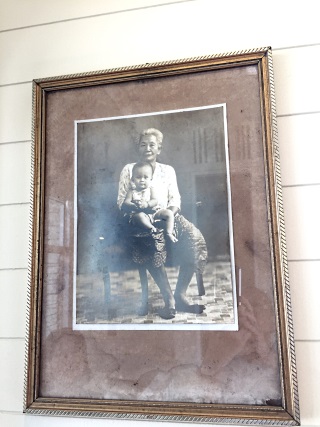
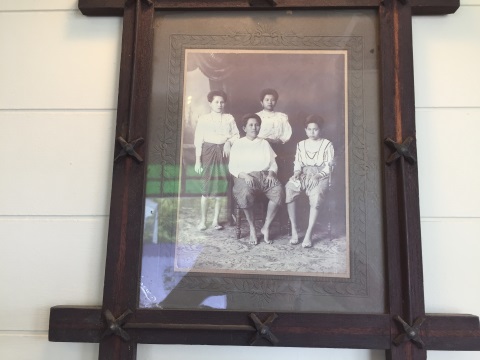
The first owner of this house – note the form of dress of that period
Another photo displays the members of the Kudichin Community in 1957, they numbered more than 300. Each person on the photograph is numbered and a register below shows the names of each of them.

Photo of members of the community in 1957
To the side, there’s a list of the 83 families that are still residing in the Kudichin community today.

The families currently living in Kudichin
This Nativity scene of Christ born in a manger was made from old newspapers mashed into paper-mache, the handicraft of Khun Navinee Pongthai, the owner of the museum.

Away in the manger
Roof gallery
There’s a fourth storey which can accommodate 10 people at a time and from here you get a roof top view of the Kudichin Community with the Chao Phraya in the distance.

Rooftop view of Kudichin with the Chao Phraya in the background
The café and souvenir shop
The café in Baan Kudichin Museum isn’t just a place for refreshments, it’s a display area by itself. Take note of the tiles on the floor, they are of Portuguese design.
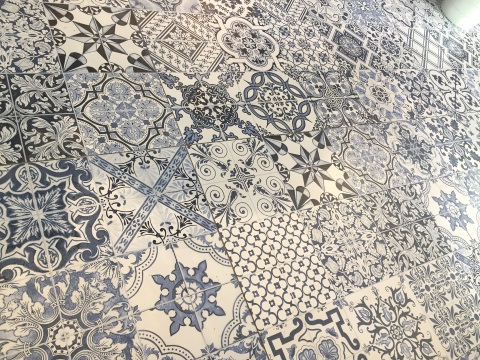
Tiles on the floor of the café – in Portuguese design
The pillar at the foot of the stairs is from the original house, a mixture of Chinese tiles and Thai script.
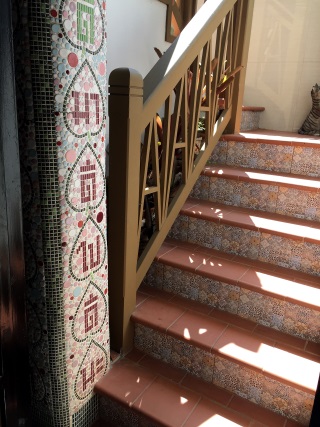
Pillar at the stairs retained from the old house
Besides the usual hot and cold beverages, the museum café displays the history of some very interesting snacks which can be traced to their Portuguese origins several centuries ago.
In 1717, there was a lady of Japanese-Portuguese descent in the court of Ayutthaya. Marie de Gimard or Thao Thong Gib Ma was a dessert chef in the royal kitchen. Many of Marie’s dessert recipes are now popular Thai deserts
There is a chart in the café showing the Thai desserts and cakes of Portuguese origin. My favourites are foy thong and luk chub. Didn’t know they were of Portuguese origin.

Luk chup – dough filled with grounded green beans, moulded into different shapes and dyed with natural material
Here’s a snack that’s served by the café, it’s called sapayak bun and consists spicy curried minced pork and small cubes of potatoes. It’s simply delectable.

Sapayak bun – a specialty of the house
These cakes called kanom Farang Kudichin were bought from a shop in the community. They are light and fluffy and melt in the mouth.
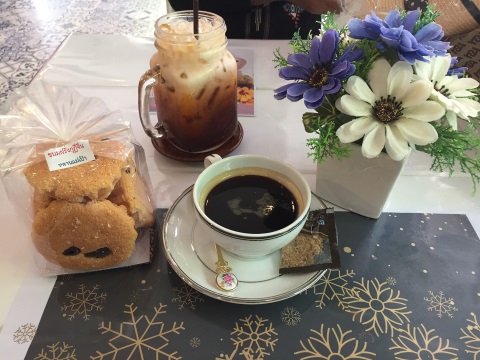
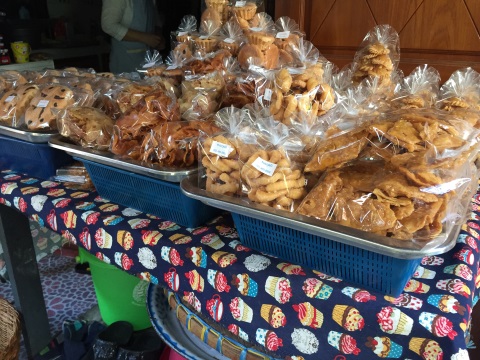
Kanom Farang Kudichin from the first shop Lan Mae Pao
There are also T shirts and other souvenirs to take away from your visit.
Garden and reading corner
Enjoy your coffee and snacks in the seating area surrounded by lush greenery and a pond dedicated to the Virgin Mary.
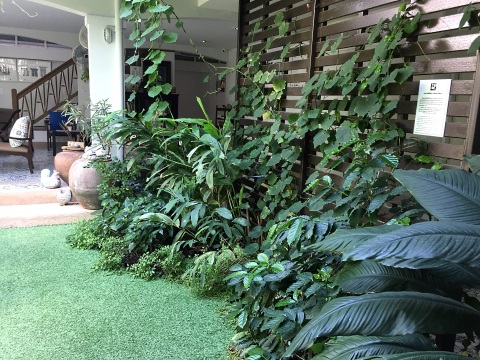
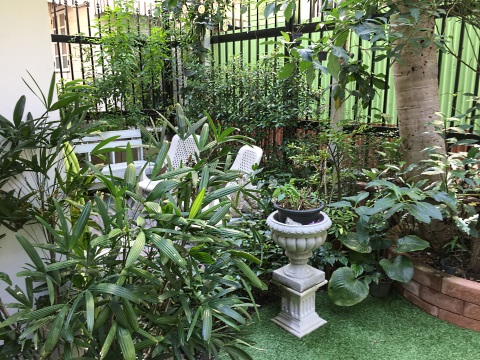
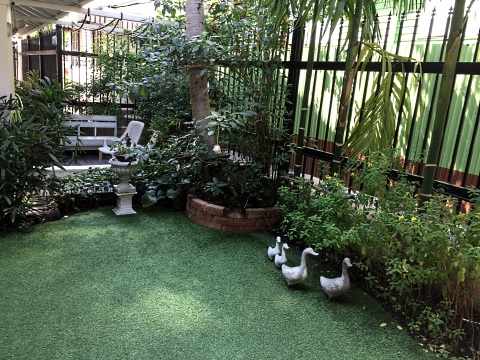
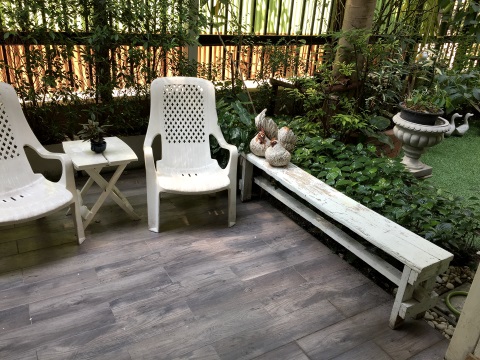
The lush garden in the Baan Kudichin Museum
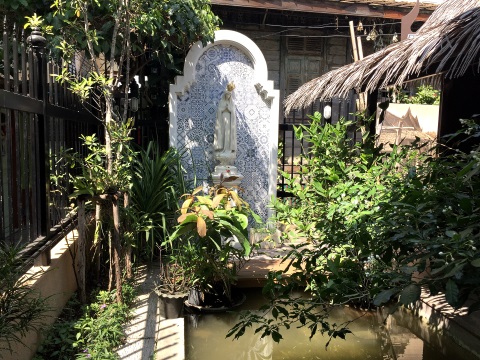
Statue of the Virgin Mary overlooking a pond
The Baan Kudichin Museum has a reading corner for visitors and residents near the refreshment area. The whole place has a refreshing and wonderful ambience to spend a day in Bangkok away from the busy and crowded areas.
Walking tour of Kudichin
After touring the Baan Kudichin Museum, take a walk along the tour route of the Kudichin Community. As you exit from the museum, turn right and follow the narrow path.
We stopped by this shop, Thanusingha Bakery House that also sells kanom farang kudichin. This route will take you out to the café by the entrance to the Santa Cruz Church. It’s an interesting walk past old houses some of which are bakeries, restaurants or cafes.
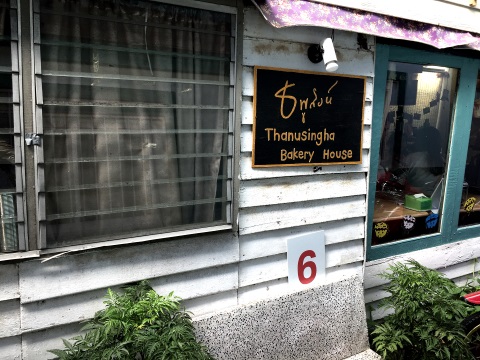
Thanusingha Bakery House
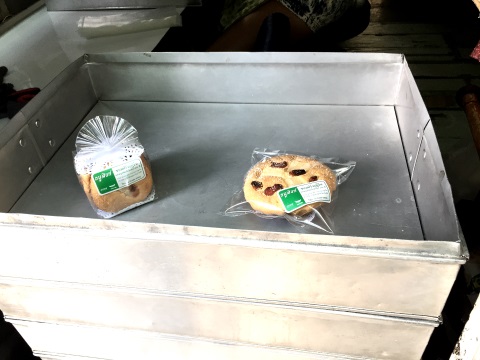
Another brand of kanon Farang Kudichin – a 200-year old recipe
Portuguese influence and power in Asia began to wane with the entry of the Dutch, British and French and from the 1600s – 1800s, her colonial influence and possessions gradually shrunk.
However, the legacy of Portuguese history and culture still prevails today in some places in Asia and one of them is Baan Kudichin, Bangkok.
Our Thanks
Our thanks to Khun Navinee Pongthai and her family for being such wonderful hosts during our visit to Baan Kudichin Museum. We are grateful that there are people who selflessly gave their homes to preserve the heritage of their community.
All photographs within the premises of the Baan Kudichin Museum are with the kind courtesy of the museum.

Thank you Khun Navinee
Map to the Baan Kudichin Museum
Or click on this link to view the map
How to get to the Baan Kudichin Museum
By car
Cross the Chao Phraya at Taksin Bridge – turn into Charoen Nakhon Road – continue on Somdet Chao Phraya Road – get on to Prajadhipok Road – U-turn and follow the route as shown on the map.
Alternatively cross the Chao Phraya at Memorial Bridge – make a U-turn on Prajadhipok Road – follow the route as shown on the map.
You can park at either Wat Prayurawongsawas or the Municipal Office carpark. Walk along the path on the river banks to Santa Cruz Church.
By the Bangkok MRT/Chao Phraya River Boat
Take the Green Line (Silom Line BTS Sky Train) to S6 Saphan Taksin Station. Go down to the Sathorn Central Pier and take a Chao Phraya river boat to the N6 Memorial Bridge Pier.
Walk through the old flower market (there’s a new riverside mall there now) to the ferry pier at Pak Klong Talat and take the ferry across the Wat Kalayanamit Pier. While you are there, drop in at Wat Kalayanamit and the Kuan Yin Shrine before proceeding to the Baan Kudichin Museum.
Address
Baan Kudichin Museum
271 Kudichin Soi 3
Tesaban 1 Road
Wat Kalaya Sub-district
Thonburi District
Bangkok 10600
Tel: 089 9242 503
Facebook: www.facebook.com/baankudichinmuseum
Web site: www.baankudichinmuseum.com
Opening times - Baan Kudichin Museum
Tuesdays - Sundays from 09:30 am – 05:30 pm.
Closed on Mondays
Admission is free. Donations are welcome.
Please remove your footwear before going up to the second floor.
For more Bangkok Museums
The Portuguese Legacy
The community church
Tour Bangkok Legacies - Kindle paperback edition
For those who prefer reading printed books rather than e-books, here's the paperback edition of Tour Bangkok Legacies, which will help you along as you explore the streets of Bangkok and discover its old treasures. It's complete with historical descriptions and directions on how to get to these places.
My Kindle paperback edition
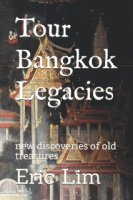
Search Tour Bangkok Legacies with DuckDuckGo
The community church
My Journey through Thailand
Part I The First Steps
My Kindle edition

My Smashwords edition



